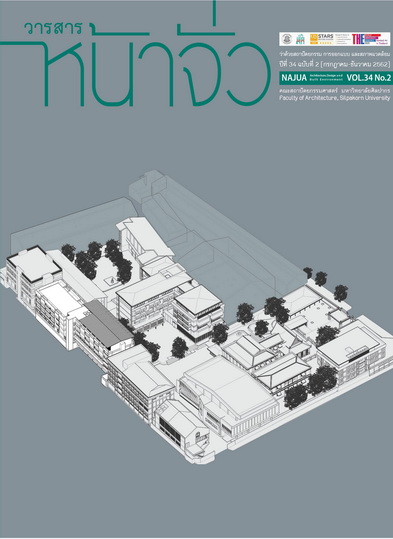Transitional space in Thai ways
Keywords:
Transitional space, Transition, Architectural space, Thai waysAbstract
Pobsook Tadtong
Doctor of Philosophy Program in Vernacular Architecture, Faculty of Architecture, Silpakorn University
Veera Inpantang
Faculty of Architecture, Silpakorn University
This paper aims to define “Transitional space in Thai ways” based on the conceptual framework that different life style generates different transitional spaces. The methods used in this paper starts with comparing various framework and theories of western and eastern transitional space, overview of meaning, representation in architectural theories through ways of life.
The result shows that, there are 3 types of transition and 6 parts of transitional space in Thai ways. Three types of transition are life-transition called “Tam Kwan”, time-transition, and inside-outside space-transition. Six parts of transitional space are elevated platform in front of staircases, entrance space, Chan (central terrace), Rabiang (verandah), Thong (hall), and door-window of each living unit in Thai traditional house.
References
- Beer, G., (2013). “Windows: Looking in, Looking out, Breaking Through”. in Thinking on Thresholds: The poetics of Transitive Spaces, 3 - 16. Mukherji, Subha. Ed. London: Anthem Press.
- Bhirom, S., (1988). Ban Thai Phak Klang. (in Thai) [Central Region Thai House]. Bangkok: Business Organization of The Office of The Welfare Promotion Commission for Teacher and Student Personnel.
- Boettger, T., (2014). Threshold Space: Transition in Architecture: Analysis and Design Tools. Berlin: Birkhäuser.
- Ching, Francis D. K., (2007). Architecture: Form, Space, and Order. 3rd Ed. New Jersey: John Wiley & Sons.
- Chompoonich, N., (1987). Ban Thai Eakalak Khong Chat. (In Thai) (Thai House, National Thai Identiy). Bangkok: Odian Store.
- Foucault, M., (1994). Different Spaces. In Aesthetics, Method, and Epistemology, 175–186. Hurley, Robert. et. al. (Trans). (1998). Faubion, James D. Ed. New York: The New Press.
- Hertzberger, H., (2005). Lessons for Students in Architecture. Rotterdam: 010 Publisher.
- Hinjirananda, N., (1994). Pathakatha Chut Sirindhorn Khrang Thi Kao: Sathapatayakam Thai. (in Thai) [Princess Sirindhorn 9th Lecture Series: Thai Architecture]. Bangkok: Chulalongkorn University.
- Jaijongrak, R., (2000). Ruean Thai Doem. (in Thai) [Traditional Thai House]. Bangkok: The Association of Siamese Architects Under Rayal Patronage.
- Kurogawa, K., (1988). Kisho Kurogawa: The Architecture of Symbiosis. New York: Rizzoli.
- Lane, J., (2013). “Between Sleep and Waking: Montaigne, Keats and Proust”. in Mukherji, Subha. Ed. Thinking on Thresholds: The poetics of Transitive Spaces. London: Anthem Press.
- Lefebvre, H., (2009). The Production of Space. Nicholson-smith, Donald. (Trans.) Blackwell: Massachusette.
- Mahakhan, P., and Mahakhan, N., (2014). “Phan Mai Nai Withi Chiwit Khong Khon Thai: Phan Mai Nai Prapheni Chiwit (Pluk Ruean Taeng-ngan Kankoed Konjuk Banphacha Samanen Upasombot Lae Kan Tai). (in Thai) [Plants in Thai Way of Living: Plant in Ceremonies Related to Life (House Building, Marriage, Birth, Topknot-cutting Ceremony, Novice and Monk Ordinations, and Death]” in Journal of Humanities and Social Sciences, 22 (38), 1-23.
- Norberg-Schulz, C., (1971). Cling, M. Ed. Existence, Space & Architecture. New York: Praeger Publisher.
- Posakrisana, P., (1997). Sao Chao Krung. (in Thai) [Bangkok Lady]. Bangkok: Ton Or Grammy.
- Satiankoset, (1963). Khwan Lae Prapheni Kan Tam Khwan. (in Thai) [Morale and Morale Tradition]. Phra Nakhon: Kao Na.
- Satiankoset, (1988). Prapheni Neuang Nai Kan Taneg Ngan Bao Sao. (in Thai). [Marriage Tradition]. Bangkok: Phap Phim.
- Winnicott, D.W., (1994). 4th Ed. Playing and Reality. London: Routledge.





